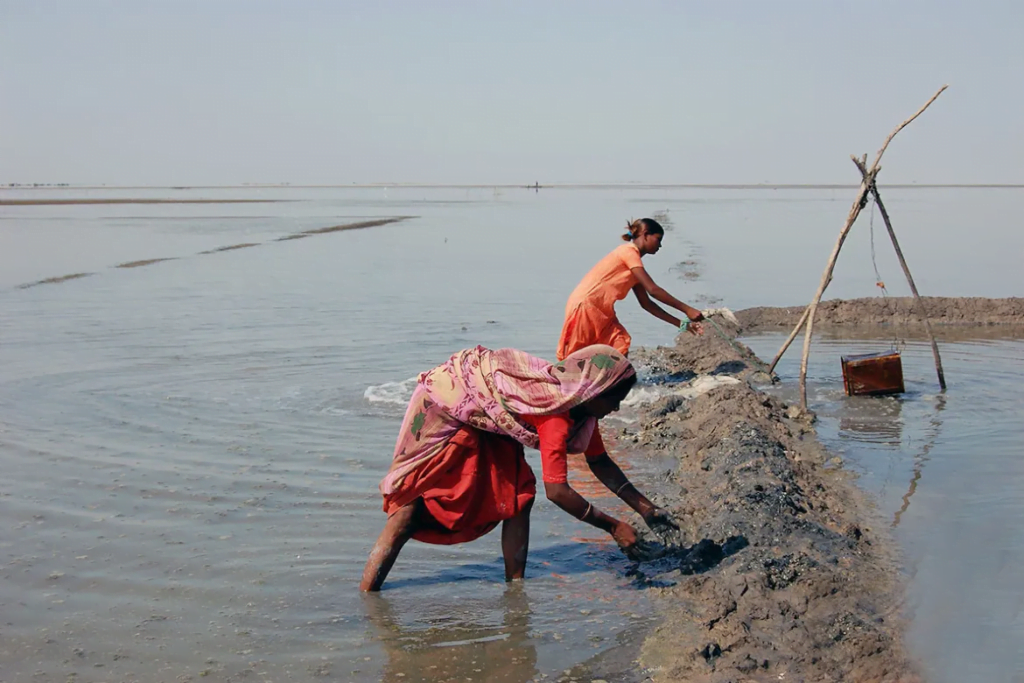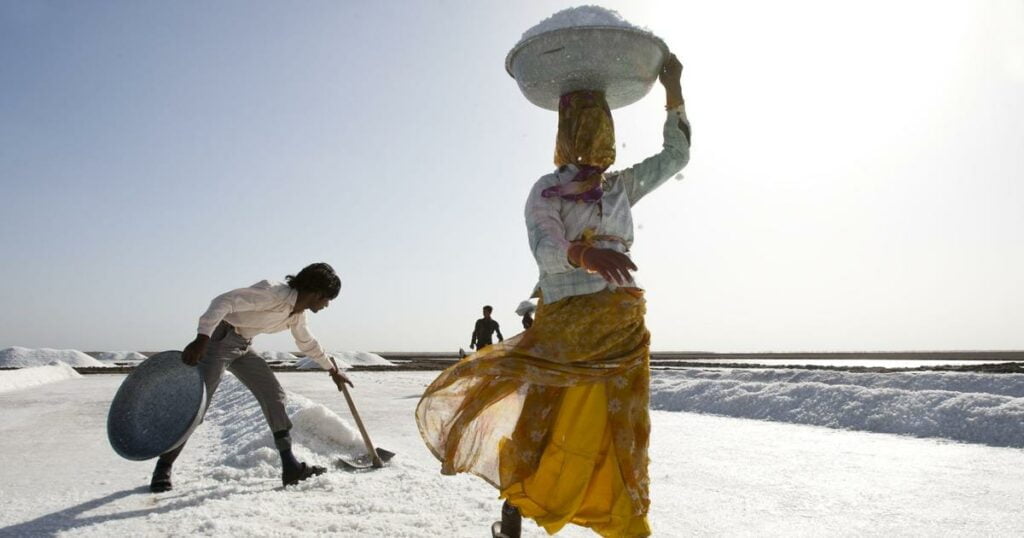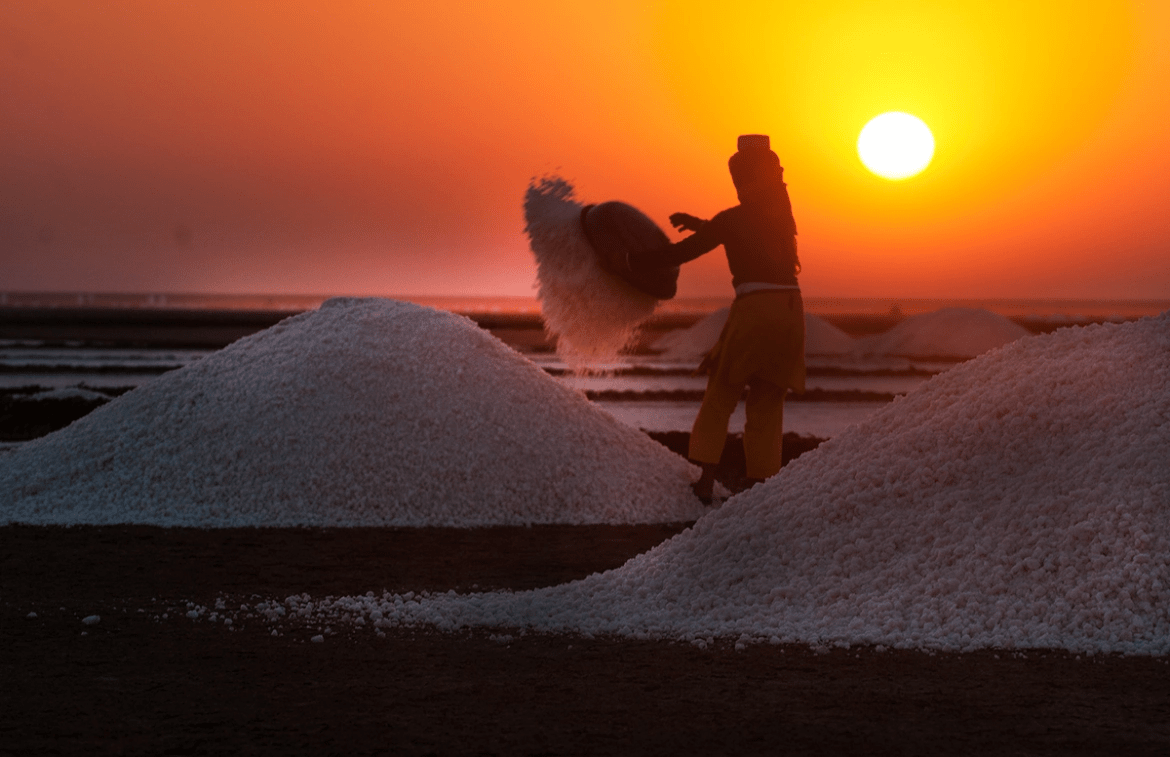Decades ago, the production of salt became a symbol of resistance against autocratic colonial rule. In 1930, the salt satyagraha inspired millions of enslaved people to unite against unjust taxation and demand independence from the British Raj. Today, independent India remains one of the largest producers of salt in the world with an annual output of more than 200 metric tonnes.
Of this ballpark figure, more than 75 per cent is produced and harvested in the rural outskirts of Gujarat. Today, salt production has become a symbol of bondage for more than 40,000 people – agariyas- who work in extreme climatic conditions, performing tasks of heavy labour that are poorly and unfairly compensated.
‘Farming’ in the desert: The process of salt harvesting
Welcome to the Little Rann of Kutch, a salt marsh situated in the Thar Desert on the western coast of India. Home to the endangered wild ass and a popular tourist attraction, this 5000 square kilometres of saline mudflats also hosts agariya families for 8 months. These salt farmers usually belong to the Chuvaliya Koli community, a de-notified tribe, and have continued their salt harvesting from generation to generation. Entire families join hands to complete the strenuous process, most of which is done manually.
In the monsoon months that usually fall between June to October on the western coast of India, the planes are completely submerged under rainwater. Post the rains, the agariya families section off the land in square pieces to prepare it for the harvest. Briny underground water is brought to the surface via manually dug wells and water pumps. This is then allowed to flood the fields as the water naturally evaporates from the heavy amounts of sunlight that the desert region receives. The actual ‘farming,’ of the salt is carried out in the winter months to protect the workers from too much exposure to the summer sun.

The entire process is heavily dependent on suitable climatic conditions and the generational knowledge that has been passed down within the families. However, with climate change on the rise, these salt pan workers have seen more issues added to their lot. Previously, agariya leaders have come forth to speak up on the issues this community faces daily.
The temporary nature of the occupation means that their settlements in the marshes are temporary too. The four months of rain allow no work to be carried out and entire families remain unemployed because of this. During this time, many male members of the house are forced to migrate to nearby cities in search of a temporary job. The women and children left behind are unprotected from the social stigma and exclusion that comes in the wake of this decision. Because the effort traditionally employs an entire family, the women of the family are often treated as unpaid laborers, while the men pocket the entire profit.
Despite the rigorous contribution, women enjoy no financial security and are trapped in households that are often abusive, having nowhere else to turn. Moreover, the settlements are constructed in rather remote regions, with no other human habitations within a 30 to 50-kilometer radius. Children as young as 10 years old are made to join in the laborious task instead of going to school, making them illiterate for life. The entire family remains trapped in this generational occupation with little to no class mobility afforded to them.
The salt of the earth: Growing environmental hazards
The hazardous environment of the salt marshes itself has created several long-term issues for these agariyas. Many have reported severe skin and eye conditions, especially in women. Hypertension is also common. Malnutrition and serious physical strain make them susceptible to several conditions, especially in women, who are traditionally allowed to consume less food and water than men and children. Local leaders and audit reports claim that these regions did not fall under the purview of the Swatch Bharat Mission, which meant that toilets are a novelty that the agariya community doesn’t enjoy.
A consequence of this is an increased occurrence of UTIs in women. A severe dearth of access to professional healthcare and potable water reserves puts further strain on their bodies. Birth complications are reported often. A recent report says that the life expectancy of agariyas seldom exceeds 60 years of age, an extremely low figure in today’s day and age.
Many have reported severe skin and eye conditions, especially in women. Hypertension is also common. Malnutrition and serious physical strain make them susceptible to several conditions, especially in women, who are traditionally allowed to consume less food and water than men and children. Local leaders and audit reports claim that these regions did not fall under the purview of the Swatch Bharat Mission, which meant that toilets are a novelty that the agariya community doesn’t enjoy.
These existent health conditions have only worsened by the effects of climate change which are more severely felt in the extreme temperatures of the Thar. Heat waves are common, and midday temperatures often shoot above 50 degrees Celcius. Most of these workers cannot afford sufficient sun protection and are forced to continue work in these extreme temperatures either barefoot or in flimsy rubber slippers.

Sometimes, the aluminium and iron tools that they use, heat up to such a degree that they are compelled to halt work for the time being. Dehydration and heat stroke become common occurrences, especially for women who are forced to continue household chores despite climatic barriers. This includes walking over 6 kilometres to find the nearest freshwater source. Other times, the agariyas pool together money to order private water tankers further eating away a huge chunk of their meagre incomes.
Recently, bouts of unseasonal rainfall have complicated matters further. The generational knowledge that the agariyas depend upon strides on the delicate balance of seasonal changes. Unaccounted rainfall occurring outside the stipulated 4 months of monsoon severely damages the output of salt production. The harvested salt is usually stored under direct sun exposure and unseasonal rain causes much of it to dissolve into the rainwater and drain away before a waterproof tarpaulin can be secured on top.
This leads to a waste of precious product that has been manufactured with care and acute human labour. Because of the nature of the plains, flooding is common, and while this natural occurrence is part of the production cycle on a regular, an untimely monsoon forces the agariyas to lose out on crucial days of work unseasonally, leading to huge monetary setbacks.
Women mining gold: SEWA’s solar intervention
While government intervention has been scarce in the region, various non-governmental actors have stepped forth to offer a helping hand. Self-Employed Women’s Association (SEWA) has been a huge influence within the agariya community, simultaneously tackling socio-cultural, economic, and environmental issues. In collaboration with universities and larger philanthropic organisations, SEWA’s modus operandi has focused on intersectional solutions for intersectional issues. Through a range of systemic innovations, SEWA has been able to promote newer ways of livelihood generation for the women of the agariya community while also laying an emphasis on energy-efficient means of production.
In 2013, SEWA introduced solar pumps to replace the more traditional diesel pumps that are used to pump out the briny underground water. These were sold to the agariyas at highly subsidised rates. Diesel was one of the most expensive raw materials that significantly ate into their incomes and a more sustainable replacement greatly helped combat this issue. The solar replacements were more efficient as well, owing to the high amounts of sunlight that the desert region receives. This meant that the production output increased as well, which together with a reduced cost of production, substantially raised the average income of an agariya family.

Moreover, SEWA took up the initiative of partnering with other NGOs that specifically trained the women of the community to operate these new pumps. This mass-scale upskilling of women also led to several socio-cultural reforms. The women became an indispensable part of the community’s economic reforms and thus commanded more respect and control over their finances. To sustain this newfound financial security, SEWA also focused on specialized financial literacy workshops for women and taught them how to invest their savings to further their businesses. This simple energy-efficient switch had large-scale impacts. Many were able to afford private schooling for their children and upward class mobility had now become a distant possibility.
After several success stories, SEWA also attracted international attention in the region. In February of this year, former United States Secretary of State, Hillary Clinton personally visited the agariya community in the Little Rann of Kutch. She interacted with them via the means of a SEWA translator and heard first-hand accounts of salt production from the ‘sisters of SEWA.’
In collaboration with the Rockefeller Foundation, she announced a Global Climate Resilience Fund of 50 million dollars, especially for women to fight climate change. This is just the beginning of a wave of change and the agariya community has been overjoyed at the prospects of development finally reaching their remote settlements.
Chinks in the development ‘armour’
Although non-governmental action has provided welcome relief, a question continues to trouble the leaders of this community. What has kept the Government so quiet?
The few policies that the Government introduced have been merely for ‘show,’ claim certain leaders of the Agariya Hit Rakshak Manch. In the last few years, especially under the regime of the present government, Gujarat has attracted special attention. There has been a significant emphasis on the ‘Gujarat Model of Development,’ in the last decade or so, but how inclusive has this ‘acclaimed,’ model of development been?

Who has been left out and forsaken in this project? There are multiple answers to this singular question and the fact is that the agariya community is only one of many. Essential to every plate, these salt pan workers toil away under direct sun, and yet live out most of their lives merely in the shadows of ‘development.’
References:
- Worth-their-salt-improving-livelihoods-of-women-salt-farmers-through-clean-energy-in-the-salt-pans-of-gujarat_2018-09-10.pdf
- The salt farmers of India’s Rann of Kutch marshes | Gallery | Al Jazeera
- Great change in Little Rann: How salt workers on the brink in Gujarat brought about a solar revolution
- Salt pan workers of Gujarat pin hope on Assembly polls for better future – ThePrint – PTIFeed
- Gujarat: ‘Salt workers living hand-to-mouth existence’ | Ahmedabad News, The Indian Express
- SALT INDUSTRY IN INDIA
- Getting Low-Cost Efficiency to Salt Pan Workers in Little Rann of Kutch
About the author(s)
Ananya is a writer and researcher of all things literature. With a particular emphasis on film, gender, and sexuality, she is great at curating the perfect movie night, but when it comes to life itself, she's still figuring out the script.






Always such interesting topics you write on and that too so well!!
Can’t bless the salt in my kitchen enough – the absence and presence of which is the game changer in every dish I cook.Grateful to all those saltworkers for working through soo many hardships to supply the most important but humble ingredient.
Very well researched and presented..thank you.
So many eye opening facts which are never discussed or heard. Well articulated. Keep it up.
Never knew, a small pinch of salt which is so essential in our lives has such a background. Thank you so much for the information. Hope the government takes notice and help this community.
Quite informative and thorough work.
God bless you always for your talent and creativity to approach such a eye opening matter at socio-economic level for those unheard community. Always gratitude to all who brings taste of food on our plate. Keep it up.
Well done Ananya. Very well written and informative article.
Very well written. So proud